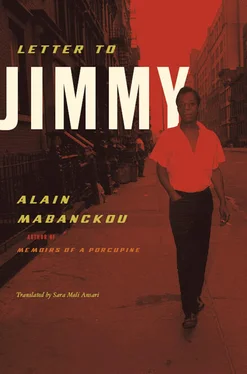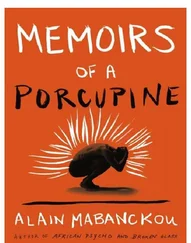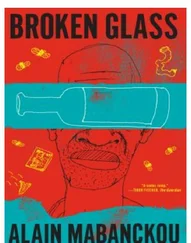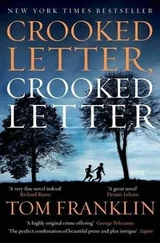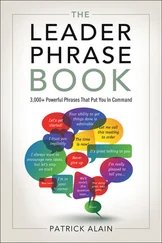Pulling yourself together, you clear your thoughts and repeat that the theory of the “white devil” never interested you: “I don’t have the feeling of ever having been even vaguely attracted to the theory of the white devil. It is certainly not I who will propagate the idea, or who will allow someone to spread the teachings to any of my children, nor to anyone who is dear to me. But it’s something else that I’m trying to get at. .” 116
You are trying to dissect the notion that Jewish suffering is considered a part of the world’s moral history. As whites, Jewish people can achieve hero status through the suffering they endured and their recollection of them — America is dedicated to a boundless admiration for the white hero — while blacks who would do the same thing would be accused of “native savagery.” In short, America’s love of the white hero would lead it to a categorical rejection of “bad niggers.” 117This is the distinction that you believe sparked black anti-Semitism in Harlem at the time. Currently, it is a distinction that still affects relations between various demographics in France, where the question of “competing for historical recognition” is being hotly debated.
You protest the silence of the Western press, for example, on the atrocities committed by Belgium during its colonization of Congo. Would we have needed to rebuke this silence had the tragedy occurred in the white world? Herein lies the responsibility that you place on the shoulders of the Christian world, since the acts of violence committed during the colonial period were accompanied by conversion of the conquered peoples: “And since the world at large knew virtually nothing concerning the suffering of this native, when he rose he was not hailed as a hero fighting for his land, but condemned as a savage, hungry for white flesh. The Christian world considered Belgium to be a civilized country; but there was not only no reason for the Congolese to feel that way about Belgium; there was no way that they could.” 118
•••
Is there a disproportionate amount of outrage sparked by an event, a disproportion linked to a kind of hierarchy of communities? Let us examine a case that took place in France, in our adopted land: the death of young Ilan Halimi in the Paris suburbs. The facts come together like the plot of a horror film. For several weeks, twenty-three-year-old Ilan Halimi is held captive by a gang from Bagneux, who torture him to death. Because he is Jewish. The French daily Le Parisien even reveals on the front page that inhabitants of this suburb were aware of the young man’s confinement, but chose not to inform the authorities. The opening pages of Gabriel Garcia Marquez’s Chronicle of a Death Foretold come to mind. .
The political reaction is strong and unanimous in the face of this crime clearly motivated by anti-Semitism. The story shocks the entire country, especially as other incidents of anti-Semitic crimes had been reported several months earlier.
Can we see evidence in this of two different degrees of outrage? To be clear — and let’s not beat around the bush about it — would the murder of a black man in France, under the same conditions, have generated the same widespread outrage?
Blacks in France undoubtedly remain unaware as yet of the “weapon” of outrage, an extension of Gandhi’s position, a new form of nonviolent action. Outrage as I am using it, Jimmy, does not mean externalizing hatred, much less the zealotry deployed with the aim of quickly repairing an injustice “by any means necessary,” but means rather exposing the incident through coherent and objective analysis. As a consequence, one community’s ability to react to it will condition another community’s interpretation of a tragedy. The greater the outrage of a community, the greater the repercussions will be on society as a whole, and, by extension, on political authorities.
However, it appears that black people in France, faced with an act of violence, first measure the extent of the outrage that a similar event perpetrated against another “community,” that they believe to be protected and more supported by political authorities, would generate. From that perspective, they begin to draw conclusions, particularly that Jewish people control the system. It is clear that the death of Ilan Halimi feeds the anger of anyone who respects human life — in the same way that the death of Emmett Till in Mississippi does — because first and foremost we are talking about the obliteration of a man’s life. The anti-Semitic motive — one could say mutatis mutandis , skin color, political convictions, etc. — adds to the exasperation, incomprehension, and the bewilderment. Ilan Halimi died because he was Jewish. He could also have died for being black, Muslim, or because he was a political opponent.
Still, in France, on March 25, 2006, several prominent French public figures, including Alain Finkielkraut, Jacques Julliard and Bernard Kouchner, added their names to an open letter against “anti-white hate crimes,” a letter initiated by the Hachomer Hatzaïr Zionist movement and Radio Shalom, following high-school student demonstrations that had occurred in the country two weeks before: “Two years ago, almost to the day, on March 26th, 2003, several of us sounded the alarm. Four young people belonging to the Hachomer Hatzaïr movement had just been attacked, outside of a protest against the war in Iraq, because they were Jewish. An attempted lynching in the heart of Paris is a scandal. The efforts of the media, political figures and humble citizens were tremendous. But today high-school student demonstrations have become, for some, an opportunity for what might be called ‘anti-white hate crimes.’ High-school students, often alone, are thrown to the ground, beaten, robbed and assured by their attackers, with smiles on their faces, that it is because they are French. Let this serve as a renewed appeal because we will not accept this, and because for us, David, Kader and Sébastien have the same right to dignity as anyone else. Writing this type of letter is difficult because the victims have been appropriated by the far right. But that which goes without saying is, in fact, better said aloud: no group should be targeted, period. For us, it is a question of fairness. We have talked about David, and Kader, but who is talking about Sébastien?” 120
Parallels between the United States are quickly drawn: during a press conference, one of the signatories of the letter, the philosopher Alain Finkielkraut, warns: “We are facing a Farrakhan-style battle.” 121
Could the black American leader of the Nation of Islam, Louis Farrakhan, influence people in France? I do not believe so, for the simple reason that the idea of a black community in France is a superficial one, and that the history of black Americans has roots which cannot be compared to the black presence in France. To make this comparison is to see every black person as a potential member of the Nation of Islam, in the way that black American Muslims understand it.
Long ago, blacks in France believed — and perhaps still believe — that having the same skin color meant speaking the same language, and facing the same direction. However, Africa is disparate, and divided. The culture of one African country is not necessarily that of another. Moreover, the displacement experienced by these countries, in addition to the displacements created by French colonial policies — including drawing colonial subjects into European wars — create personal histories deeper than any collective history of meeting in the “land of refuge.” Education, political asylum, financial reasons and civil war on the black continent cannot give rise to a common history. These issues are neither specific to nor define the black race.
Читать дальше
